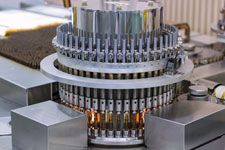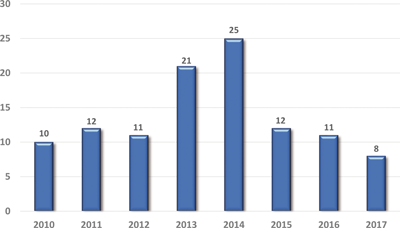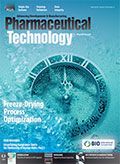Improving Visual Inspection
Updated guidelines and new technologies aid visual inspection of parenteral products and packaging.
RGtimeline/Shutterstock.com

Parenteral product quality is improving. Since 2014, when USP <790> “Visible Particulates in Injections” (1) became official, particle-related recalls of injectable products have dropped significantly (see Figure 1).
However, “I want to be cautious and not give all of the credit to USP <790>,” says John G. Shabushnig, PhD, owner and principal consultant at Insight Pharma Consulting and leader of the Parenteral Drug Association’s (PDA’s) Visual Inspection Interest Group. “There was a lot going on during this period including significant recalls from compounding pharmacies; however, I do think having clear guidance on inspection and acceptance criteria was a contributor to this drop.”
Publication of USP <1790> “Visual Inspection of Injections” (2) is another positive influence. Shabushnig says, “USP <1790> provides a more complete picture of good practices when implementing and operating a visual inspection program. It also clearly discusses a lifecycle approach to inspection, with an emphasis on continuous process improvement and using inspection data to drive that process. Defect prevention should always be the primary goal.”
In addition, there continues to be a shift toward lower acceptable quality limit (AQL) values for acceptance sampling after 100% inspection, according to a benchmarking survey (3) performed in 2014 by PDA. Shabushnig says, “This trend is especially true for critical defects, having moved from 0.10% to 0.065%. More firms are classifying particles as critical defects despite an implied classification as a major defect, which would have a mean AQL of 0.65%, in USP <790>. The subsequent PDA benchmarking survey for difficult-to-inspect products also showed that many firms have not adopted the supplemental (destructive) testing specified for these products in USP <790>. Examples include reconstitution of lyophilized or powder products or dilution or filtration of opaque or strongly colored solutions.”
Figure 1. FDA recall notices for particles in injectable drug products, 2010-2017. Prepared by John Shabushnig with data obtained from the FDA Recall and Safety Alerts Archive, accessed March 13, 2018. Figure is courtesy of John Shabushnig.

Automated inspection
Wider adoption of automated inspection ranks as another positive force on product quality. This effort begins with container production. “Aiming for zero defects in our pharmaceutical packaging production, we employ an automated inspection system (AIS),” reports Michael Feldhaus, director of Technology at Schott Pharmaceutical Systems. “This 100% visual inspection technology examines all key surfaces of our vials and cartridges and merges cutting-edge machine vision technology with our decades-long glass-forming expertise.”
Feldhaus explains, “Camera inspection allows for inline process control. The sensitivity and reliability of the system enable us to perform 100% cosmetic inspection for vials and pen cartridges, resulting in high-quality pharmaceutical containers. In addition, the data help us optimize process control.”
With quality control demands escalating continuously, both the software and hardware used for cosmetic inspection have improved significantly. “For example,” Feldhaus says, “we have further developed our AIS software, which creates a 3D image of the container based on visual material from multiple cameras with different light settings. This process allows the container surface to be analyzed in a more comprehensive way. Moreover, machine learning technology helps detect patterns and improve the process further. On the hardware side, higher processing power and improved illumination enable systems to provide more data and sharper images. In addition to using improved machinery, our employees regularly take part in training to strengthen their overall quality awareness and ensure our products meet high quality demands.”
Makers of parenteral packaging components such as closures and stoppers also rely on automated inspection. Datwyler Pharma Packaging Division uses advanced 100% camera inspection technologies and improved lighting sources to ensure product quality throughout its manufacturing process. Increased processing power permits use of more powerful detection algorithms, which improve detection capabilities and minimize false rejects. As a result, “some of the most critical production defects have been brought to the lowest level ever recorded,” reports Dirk Vander Mierde, Datwyler’s site director in Alken, Belgium. Potential defects caught by the system include the presence of foreign matter, deformation, or damaged coating. In addition, any rejects undergo additional inspection to help identify ways to improve the process.
On parenteral packaging lines, automated inspection tends to be limited to high-volume operations due to capital and validation costs. As a result, manual inspection continues to dominate with approximately 50% of firms relying on it, according to the 2014 PDA benchmarking survey (3). Shabushnig reports, “Approximately 30% use automated inspection with the remaining 20% using semi-automated systems.” He notes, “This is actually a drop in the response rate for automated inspection since the 2008 survey (3). This does not, however, mean that fewer companies are using automated inspection; rather, there are differences in which companies respond to the survey each year. More importantly, the survey is structured so that each company/site has a single ‘vote.’ That vote counts the same if the company/site is making 10,000 or 100,000,000 units each year. If the results were normalized for units produced, I believe we would see more units inspected by automated systems. We should also note that manual inspection continues to be the reference visual inspection method in all of the pharmacopeias and that smaller-volume operations will continue to use manual inspection for the foreseeable future. Automated inspection does not ensure greater detection ability, and a well-run manual inspection process is very capable of delivering a high degree of security.”
Improvements to inspection equipment
Meanwhile, automated inspection continues to evolve and protect product quality with enhanced lighting, flexibility, container handling, and speed.
“LED lighting has provided a great improvement to our automatic inspection machine (AIM) in several ways,” reports Jose Zanardi, head of Vision Technology Engineering at Bosch Packaging Technology. LED lighting reduces downtime due to less frequent bulb changes and post-change verification. It also provides a consistent light level, eliminating the need for the inspection machine to compensate for light degradation. Compared to the halogen lighting it replaces, LED illumination generates less heat, eliminating concerns about product exposure to potentially damaging temperatures and the need for time-out programming for lamps.
“LED lights offer both precision and flexibility,” says Christopher Nerreau, area sales manager at Laetus US, which introduced LED lighting for machine vision in 1994. Combining low cost and easy implementation, options address virtually any application with bicolored, ultraviolet, or standard LED illumination.
Higher resolution cameras and customizable software also enhance flexibility. For example, Bosch’s Halcon vision system in its flagship AIM 8 series provides a standard vision tool that can be customized to maximize identification of visual defects. Zanardi notes customized inspection algorithms are essential to protect the quality of parenteral products. He explains, “Most of the medicines produced today pose challenges for inspection due to product clarity, viscosity, and fill volume, as well as container challenges such as dual chamber design, increased use of plastic, and influence of siliconized components, which attract both product and foreign particles.”
Other new features on equipment from Bosch include a patented, dynamic puck material handling system. It eliminates glass-to-glass or glass-to-hard-surface contact and minimizes size changeover time via a semiautomatic puck exchange system. Finally, Bosch has developed a fourth-generation static division unit. The SD4 module inspects particles in motion and offers the highest reliability for solutions and light suspensions with easy-to-develop recipes and validation.
Despite advancements in software, off-line image storage and analysis, and inspection speed, automated inspection systems using machine vision still pose challenges related to tuning and validation complexity. “Machines also have difficulty in managing the ‘normal’ variation found in many container closure systems,” says Shabushnig. “This difficulty is especially true for molded vials, which results in a high false reject rate (i.e., acceptable units that the machine rejects to assure that true rejects are detected with sufficient sensitivity and certainty).”
In addition, challenges remain with line integration and interpreting inspection results. Shabushnig explains, “In most cases, a scratch and a crack look the same to a machine yet have differing risks to patients (critical vs. minor). This limitation makes analyzing reported inspection results difficult and often requires a reinspection of rejected units to assess the type of defects found in the batch.”
For optimum line performance, automated inspection must integrate with equipment before and after filling. Nerreau notes, “There is a wide variety of parenteral products requiring vision solutions. Some examples include: using color identification to recognize color-coded needles, pattern matching to identify missing products in the package, optical character recognition to identify expiration dates on vials, and serialization for security.” Each application poses challenges for machine integration.
Prior to filling, inspection equipment typically connects to exterior washing or capping machines. After filling, the typical connection is to container closure integrity testing equipment using high voltage or laser headspace or vacuum technology, or to a re-nester/re-trayer for syringe applications. “Ensuring proper container transfer with sensors to manage product flow is essential to the integration process,” says Zanardi. In projects where glass-to-glass contact must be eliminated, precise design engineering is necessary to assure that container handling and machine starts and stops do not damage the product or the machine.
“To perform complex image processing tasks in quality control environments, it is essential that the camera and lighting systems are tailored to the specific application,” says Nerreau, adding, “It is imperative for any machine integration to include extensive discussions and intensive consultations early on, along with a personal survey of the production environment.”
Next steps
With the industry focused on quality improvement, visual inspection continues to be a hot area, reports Shabushnig. A project at PDA is addressing visible particles in injectable products, with a current focus on improvements to the primary packaging materials. It seeks to better understand the risks as well as methods to detect and control particles in these components. This project is supported by both pharmaceutical manufacturers through the Pharmaceutical Manufacturers Forum and a number of primary packaging component manufacturers.
PDA’s Visual Inspection Interest Group was to meet in April 2018 in the United States and in Europe to discuss the draft revision of Annex 1 (4). “Changes included significant expansion of sections associated with visual inspection and container integrity,” says Shabushnig. In addition, PDA continues to provide hands-on training in the area of visual inspection in the US, Europe, and Brazil.
Meanwhile USP continues to review comments and Âsuggestions for USP <790> and <1790>. “Current topics of interest include the selection and use of sampling plans for USP <790> and using risk-based methods to set alternative acceptance criteria for particles,” reports Shabushnig. “The Expert Panel responsible for these chapters is always interested in feedback to improve the understanding and use of these chapters,” he concludes.
References
1. USP, USP General Chapter <790>, “Visible Particulates in Injections” (US Pharmacopeial Convention, Rockville, MD, 2014).
2. USP, USP General Chapter <1790>, “Visual Inspection of Injections” (US Pharmacopeial Convention, Rockville, MD, 2017).
3. J. Shabushnig, “PDA Survey: 2014 Visual Inspection” (Parenteral Drug Association, 2015).
4. EC, Consultation Document for Revision to EudraLex Volume 4: Good Manufacturing Practice Guidelines, “Annex 1, Manufacture of Sterile Medicinal Products,” accessed Feb. 28, 2018.
Article Details
Pharmaceutical Technology
Vol. 42, No. 5
May 2018
Pages: 52–54
Citation
When referring to this article, please cite it as H. Forcinio, "Improving Visual Inspection," Pharmaceutical Technology 42 (5) 2018.
About the Author
Hallie Forcinio is Pharmaceutical Technology’s Packaging editor, editorhal@cs.com.

Understanding the Variability in Bioburden Test Results in Biomanufacturing
May 7th 2025This article explores the impact of test volume, microbial distribution, and dilution errors on bioburden testing variability. It presents statistical approaches to estimate percentage error and discusses strategies to optimize microbial enumeration techniques in biopharmaceutical quality control.
Trump Directs FDA, EPA to Reduce Regulatory Barriers to Domestic Pharma Manufacturing
May 7th 2025The White House is instructing FDA to increase fees for and inspections of foreign drug manufacturing plants and reduce the time required to approve such sites that will be newly constructed in the US.